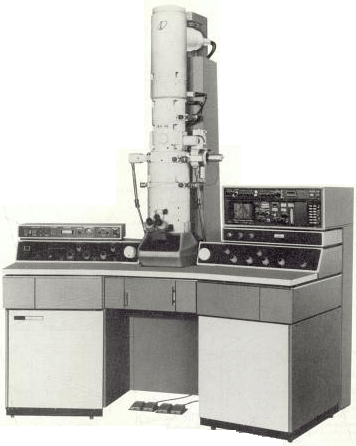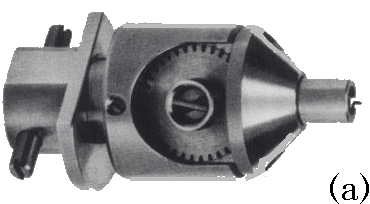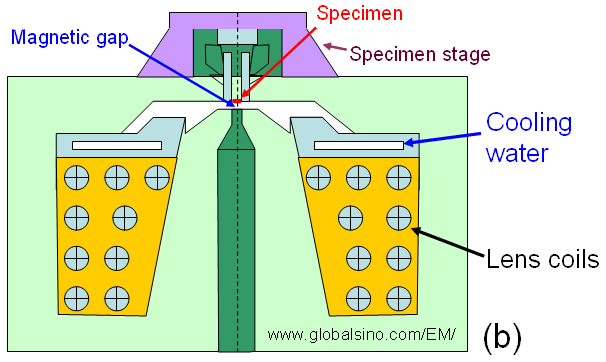| In general, top-entry TEM/STEM holders have the properties as follows:
a) Setup:
a.i) They have cartridges that are several cm long with a bore drilled down the cartridge axis as shown in Figure 4948b. We normally use a small screw ring to mount the specimen in place. The specimen must be smaller than the bore diameter. This specimen cartridge is inserted into an airlock by a rod through a bore perpendicular to the TEM optic axis, and the specimen and part of the holder fit through the bore of the upper polepiece from above (the bore hole is aligned with the electron beam axis.). The cartridge is then detached from the out-side world when we use the microscope. In this way, the TEM specimen is dropped into (or called “immersed in”) the center of the lens field, so that it is surrounded by the objective lens. Therefore, the electron beam travels down the cartridge bore and into the specimen.
a.ii) An actual cup that holds the specimen is between 2 and 5 mm in diameter, and the specimen disk or support grid has to be the same dimension.
a.iii) Some special mechanisms in some microscopes may accommodate up to six specimen holders.
a.iv) In order to insert a tilting holder, the top entry pole piece requires a relatively large upper bore. In some designs, the maximum tilting angle can be about 30°.
b) Advantages:
Comparing with side-entry stage, previously they were much less susceptible to vibrations and thermal drift, and thus enabled higher specimen stability (especially for HRTEM) since they were not connected directly to the outside. Therefore, it was theoretically and empirically suggested that resolution with top-entry holders was slightly higher than that with side-entry stage, for instance, 0.24 nm for the top entry stage versus and 0.27 nm for side entry stage at an accelerating voltage of 200 kV before.
c) Disadvantages:
c.i) The bore of the objective lens must be asymmetric, which actually limits the extremely high resolution.
c.ii) It is usually noneucentric, i.e. the specimen translates out of the selected area if it is tilted.
c.iii) It is more difficult and expensive to design and to rotate, heat, cool, or strain the specimen.
c.iv) It is impossible to get X-ray detectors near the specimen in EDS analysis so that analytical microscopy is very inefficient.
c.iv) If the focal length is kept really short to give the highest spatial resolution, then such designs are typically unable to be tilted more then a few degrees without blocking the beam path or interfering with the objective lens. Moreover, incorporation of the tilting mechanisms requires a larger upper pole piece bore which degrades the optical properties of the objective lens.
c.v) It is difficult to combine with airlocks and atnticontamination.
Examples of TEMs with top-entry goniometer stages are JEOL-2000EXII and JEOL 200 CX (see Figure 4948a) with sample-tilts of ±10°. Figure 4948b shows the top-entry holder for a Zeiss EM-900 TEM and the schematic illustration of top-entry specimen stage together with the top-entry lens.

Figure 4948a. JEM-200CX TEMSCAN.
 
| Figure 4948b. (a) A top-entry holder for a Zeiss EM-900 TEM. (b) Schematic illustration of top-entry specimen stage together with the top-entry lens. |
Comparing with side-entry specimen stages, top-entry specimen stages have better probe system parameters (e.g. Cs and Cc), and the X-ray spectrometers closer to the specimen.
|
